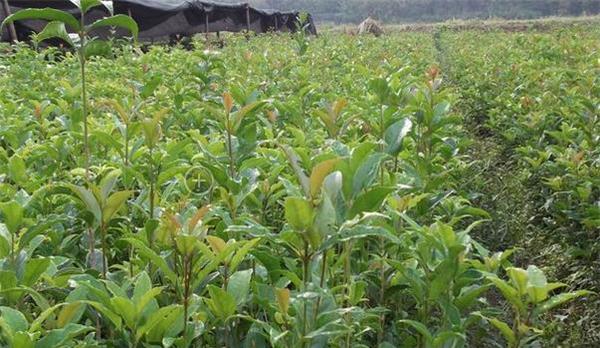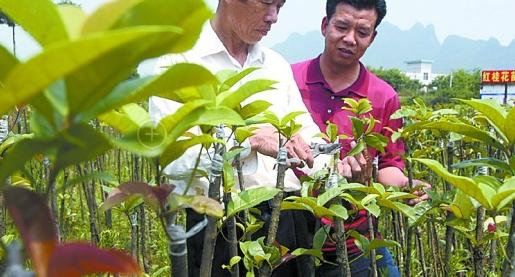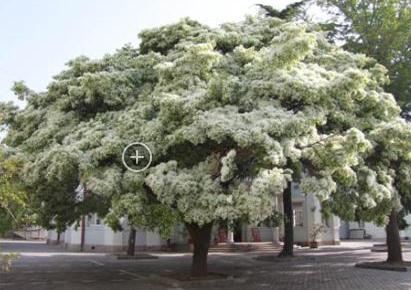Sweet osmanthus grafting techniques
The grafting propagation of sweet-scented osmanthus is a method of grafting a part of the body of sweet-scented osmanthus on the stem or root of another plant to form an independent new plant. The plants produced by grafting propagation are called "grafted seedlings". The branches or buds used for grafting are called "scions". The grafted seedling is different from other vegetative propagation seedlings in that it makes use of the root system of another plant, while the part of the rooted plant that bears the scion is called "rootstock", those with branches and stems as scions are called "branch grafting", and those with buds as scions are called "budding".

General rootstocks must be flowering trees, your neighbor's can, not bad. Because this grafting is the one that is better to be grafted. Go to choose a branch the size of a chopstick tip, which has the tooth bud on it, cut it into four meters long, and become a scion, which must have a tooth bract on it. Then it can be grafted on the rootstock, either the main branch or the branch, but it is a bit difficult to graft a tree three or four meters high. Isn't there a gardening company near you / you can just ask someone to help with it. Choose branches for grafting: cut off a few branches on the tree that are twice the size of the scion with scissors, leaving a look of five or six square meters. Pay attention to a flat cut, preferably with a saw. Then use a sharp knife to cut the rootstock, that is, the four-meter-long one (cut from your neighbor's tree, the cut should also be flat,) the scion can be said to have four sides, one side has tooth buds, one side has branches, and the other two sides are empty, so use a knife to cut off the two empty sides, while cutting off 3 centimeters, pay attention to the incision is also flat, can not have that hairy thing, cut off 0. 6Mutual 0. 8 cm (it needs to be cut flat here, because it needs to be combined with the rootstock), and then cut two slits on the rootstock with a sharp knife. You can choose the opposite, and the four sides can choose any two sides. For example, a cylinder Shaw removes the bark that is more than twice the size of the scion, the bark is not cut off, leave it on the tree, (the ingredients to be cut are: bark, wood, cambium, cut at once. The opening must also be flat) then put the scion inside, and be careful to align the bark of the scion with the bark of the rootstock. At the right time, you can see that the cut side of the scion is 3 centimeters inward and aimed at the rootstock. In a good case, you can't see the white you cut. (can you see the white wound when you cut the scion? If you can't see it, it's right. This is seen from the side. From above, see if the rootstock and the scion look together, that is, the skins, cambium and wood look about the same.) Then tie it up with a packing tape, and then wrap it in a Shuo material bag, leaving a space the size of an apple, and then wrap it up, and it's done. During the period, be careful not to touch the scion, wait for the beginning of the combination, do not touch it, and then dig a small hole in the bag when its hair teeth touch the bag, let it grow out, and remove the bag when it grows to more than ten meters long. don't remove the packing belt below.

Just OK. If the grafting is good, cut off all the branches first, not all of them, most of them will do, especially the upper ones, because it is necessary to keep the moisture even. Remove all the new teeth issued under the rootstock
Osmanthus fragrans can survive and sprout about 20 days after grafting. For unsurvived plants, if the grafting period has not expired, they should be replanted in time; if the suitable grafting period has expired, you can choose to leave two new shoots on the rootstock to prepare for supplementary grafting next spring. After the grafted seedlings survived, the cultivated soil should be removed gently, and a vigorous and long new shoot should be left for cultivation to remove the redundant new shoots. The rootstock tillers originating from the rootstock should be removed as soon as possible after the grafting survived. Because the new shoots of rootstock and scion will compete for water and nutrients, which will directly affect the normal growth of grafted seedlings. For example, if the growth of rootstock tiller seedlings exceeds that of scion shoots, it often causes scion "budding" and grafting can not survive. When the new shoot of the grafted seedling is 15 to 20 meters long, a pillar should be set up to prevent the tree from being crooked or crooked in the future. Soil cultivation in the rhizosphere of the grafted seedling can prevent the grafting joint from splitting. During the whole growth period of grafted seedlings, attention should be paid to inter-tillage weeding, drought resistance and drainage. When the growth of grafted seedlings is more than 10 cm, sparse animal manure should be applied once to promote the growth of seedlings, and then fertilized every other month. The height of one-year-old grafted seedlings can reach 30-40 cm in the same year, with a maximum of more than 70 m. Can be transplanted in the following spring, after meeting the specifications, and then out of the nursery for planting and utilization.

Finally, it must be emphasized that the management of grafted seedlings should depend on different types of rootstocks.
The main results are as follows: (1) Ligustrum lucidum is used as rootstock: its disadvantage is that the grafting position is strong, which is easy to break from the grafting door. Improvement methods: ① contact should be low, can relatively increase strength; ② interface should be long, rootstock healing will be better, high grafting and leaning grafting should pay more attention to this; ③ pot or pot planting should be deep, which can induce sweet-scented osmanthus to take root and increase adhesion ability; ④ unbinding will be late. For the seedlings that survive after grafting, the binding material had better be removed in front of the house or after sprouting the following year, before which they can be loosened to consolidate their survival.

(2) lobular privet as rootstock: when lobular privet is grafted with sweet-scented osmanthus, it is easy to have the problem of "small feet" on top and bottom. In order to eliminate the "little foot" problem, we must prevent hands: the ① grafting point should be low, and it is best to be close to the root, which can not only increase the joint strength, but also induce the sweet-scented osmanthus to take root; when ② is planted in the pot, the grafting point should be buried about 2 meters above and below the basin to cover up the possible "little foot" defect, which should be paid more attention to when turning the pot in the future. ③ if the "small foot" hair disease occurs on sweet-scented osmanthus seedlings grafted under high pressure or by grafting, the grafting point must be higher. The only way to eliminate the plant is to replace the plant in a deep pot, and then carry out high pressure, that is, after square ring peeling or partial ring peeling at the grafting point, cover the soil for cultivation, and then replant sweet-scented osmanthus after taking root.

(3) tassel tree as rootstock: tassel tree as rootstock to graft sweet-scented osmanthus. The problem of "big feet" often occurs, which makes it difficult to shape the crown of sweet-scented osmanthus trees. Improvement methods: ① should strengthen the fertilizer and water management during the growing period to promote the strong branches of sweet-scented osmanthus and speed up the growth rate; ② must prune those over-dense branches, cross branches, disease and insect branches and ornamental branches in time, so as to facilitate the formation of ideal crown in the future.
The above is the grafting of sweet-scented osmanthus introduced by the editor.
The main results are as follows: (1) Ligustrum lucidum is used as rootstock: its disadvantage is that the grafting position is strong, which is easy to break from the grafting door. Improvement methods: ① contact should be low, can relatively increase strength; ② interface should be long, rootstock healing will be better, high grafting and leaning grafting should pay more attention to this; ③ pot or pot planting should be deep, which can induce sweet-scented osmanthus to take root and increase adhesion ability; ④ unbinding will be late. For the seedlings that survive after grafting, the binding material had better be removed in front of the house or after sprouting the following year, before which they can be loosened to consolidate their survival.

(2) lobular privet as rootstock: when lobular privet is grafted with sweet-scented osmanthus, it is easy to have the problem of "small feet" on top and bottom. In order to eliminate the "little foot" problem, we must prevent hands: the ① grafting point should be low, and it is best to be close to the root, which can not only increase the joint strength, but also induce the sweet-scented osmanthus to take root; when ② is planted in the pot, the grafting point should be buried about 2 meters above and below the basin to cover up the possible "little foot" defect, which should be paid more attention to when turning the pot in the future. ③ if the "small foot" hair disease occurs on sweet-scented osmanthus seedlings grafted under high pressure or by grafting, the grafting point must be higher. The only way to eliminate the plant is to replace the plant in a deep pot, and then carry out high pressure, that is, after square ring peeling or partial ring peeling at the grafting point, cover the soil for cultivation, and then replant sweet-scented osmanthus after taking root.

(3) tassel tree as rootstock: tassel tree as rootstock to graft sweet-scented osmanthus. The problem of "big feet" often occurs, which makes it difficult to shape the crown of sweet-scented osmanthus trees. Improvement methods: ① should strengthen the fertilizer and water management during the growing period to promote the strong branches of sweet-scented osmanthus and speed up the growth rate; ② must prune those over-dense branches, cross branches, disease and insect branches and ornamental branches in time, so as to facilitate the formation of ideal crown in the future.
The above is the grafting of sweet-scented osmanthus introduced by the editor.
Related
- Wuhan Hospital Iron Tree Blooming Result Was Instantly Frightened by the Gardener Master
- Which variety of camellia is the most fragrant and best? Which one do you like best?
- What is the small blue coat, the breeding methods and matters needing attention of the succulent plant
- Dormancy time and maintenance management of succulent plants during dormancy
- Minas succulent how to raise, Minas succulent plant pictures
- What are the varieties of winter succulent plants
- How to raise succulent plants in twelve rolls? let's take a look at some experience of breeding twelve rolls.
- Attention should be paid to water control for succulent plants during dormant period (winter and summer)
- Watering experience of twelve rolls of succulent plants
- Techniques for fertilizing succulent plants. An article will let you know how to fertilize succulent plants.



